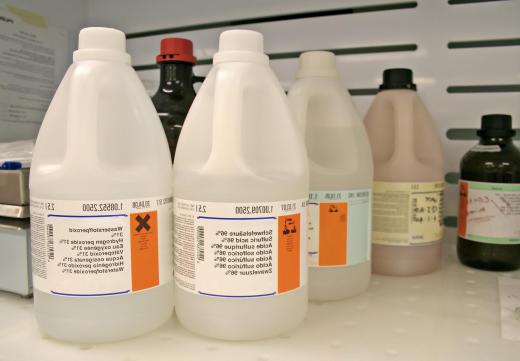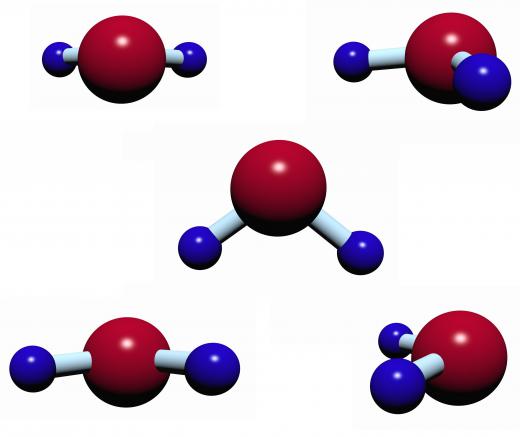What Is the Function of Sulfuric Acid in Esterification?
Esterification, or the combining of an alcohol with an acid to produce an ester, is a form of condensation reaction, since water is eliminated in the process. The reverse reaction can also occur: the ester can recombine with water to produce the alcohol and acid. In some cases, this "de-esterification" can be prevented by the introduction into the reaction vessel of a small amount of sulfuric acid. It assists by combining with the water produced, and in effect tying it up. Primarily, the benefit of sulfuric acid in esterification is that it acts as a proton donor, increasing the rate of reaction between the acid and the alcohol; when the acid used is a carboxylic acid, the reaction is sometimes called a Fischer-Speier esterification.
Carboxylic acids (R-COOH, where the R is an organic attachment) may be too weak to use, unaided, for an esterification reaction. A strong proton donor is needed to make the carboxylic acid act as if it were, of itself, a good proton source. Sulfuric acid in esterification accomplishes the task by injecting a proton into the carboxylic acid structure through the reaction H2SO4+R-COOH→HSO4-+R-C+(OH)2. The alcohol molecule, R′-OH, with its electron-rich oxygen atom, is drawn to this protonated carboxylic structure, and forms a complex conglomerate, R-C+(OH)OR′+HSO4-→R-C(O)-R′.

This arrangement of atoms and charge is not very stable, so it undergoes a proton (H+) shift, namely, R-C(OH)(O(H2)+)-OR′. In this state, it is easy for the clearly identifiable water molecule to depart, giving increased stabilization and leaving behind the energetically more favorable species, R-C+(OH)OR′. Finally, regeneration of sulfuric acid completes the process:

Interestingly, esterification does not require separate alcohol and acid molecules, but reaction can occur in some instances within a single molecule containing both moieties, or functional molecular groups. Certain conditions must be met: both the hydroxyl and carboxylic groups must be unhindered spatially, and capable of undergoing each step of the process unimpaired. An example of a molecule that can undergo this type of esterification is 5-hydroxypentanoic acid, HO-CH2CH2CH2CH2COOH. The ester produced by this form of esterification, which results in ring closure, is called a lactone — in this instance, δ-valerolactone. Positioning of the ring oxygen (-C-O-C-) in comparison to the carbonyl (C=O) group is what is indicated by the Greek letter, delta.
Sulfuric acid in esterification is not generally used in connection with tertiary alcohols — those which have their hydroxyl-bearing carbon atom attached to three other carbon atoms. Dehydration without ester formation occurs in tertiary alcohols when in the presence of sulfuric acid. As an example, tertiary butyl alcohol, (CH3)3C-OH, when combined with sulfuric acid, produces isobutylene, (CH3)2=CH2+H2O. In this instance, the alcohol is what is protonated, followed by the departure of a molecule of water. The use of sulfuric acid in esterification is not a viable methodology for preparing tertiary esters.
AS FEATURED ON:
AS FEATURED ON:












Discuss this Article
Post your comments